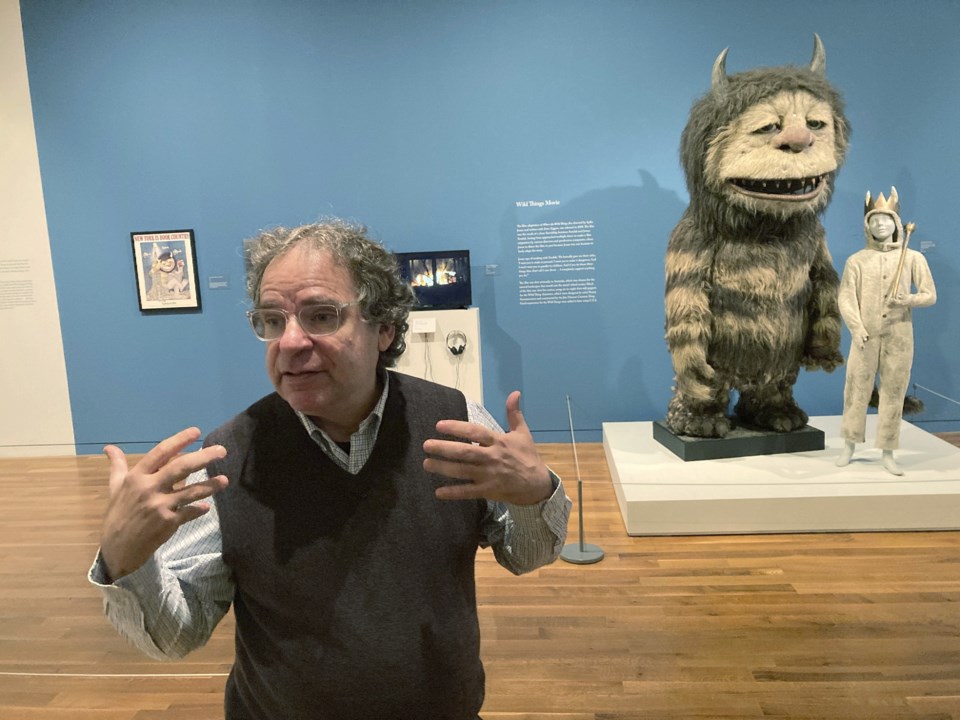COLUMBUS, Ohio (AP) ā Most people today know artist Maurice Sendak as the creator of children's book classics such as āWhere the Wild Things Areā and āIn the Night Kitchen.ā A new exhibition of his work looks at that reputation and a less well-known side of his immense output: his work as a designer for opera, theater, film, and television.
āWe wanted people to understand that Maurice was actually a serious artist,ā said Lynn Caponera, executive director of the Maurice Sendak Foundation in Ridgefield, Connecticut. Though most knew him as an illustrator and picture book artist, āthey didnāt see beyond the fact that he did a lot more than that,ā she said.
āWild Things are Happeningā opened this month at the Columbus Museum of Art and runs through March 5, 2023. It's the first major retrospective of Sendakās work since his and the largest and most complete to date.
The exhibit takes its name from a 1990s advertising campaign Sendak did for Bell Atlantic that featured Wild Things characters promoting āa fast, dependable Internet service.ā
The exhibit features more than 150 sketches, storyboards and paintings of work Sendak did for his own books, including āHigglety Pigglety Pop!,ā which he based on the fatal sickness of his beloved Sealyham terrier Jennie. The show also displays some of Sendak's most celebrated illustrations of other writersā work, such as Else Holmelund Minarikās āLittle Bearā books.
To commemorate Sendak's affinity for Mickey Mouse ā who first appeared in 1928, the year Sendak was born ā the exhibit includes an illustration that TV Guide commissioned in 1978 for Mickey Mouse's 50th birthday featuring Sendak, also 50, waving at a mirror as the cartoon character waves back.
In the late 1970s, Sendak embarked on a second career as a costume and stage designer. His design work for operas included KrĆ”saās āBrundibar,ā Mozartās āThe Magic Fluteā and āThe Goose of Cairo,ā and Prokoļ¬evās āThe Love for Three Oranges.ā A video on repeat at the exhibit features the design work Sendak did for a new production of Tchaikovskyās Nutcracker commissioned in 1981 by the Pacific Northwest Ballet.
Sendak also designed sets and costumes and wrote the book and lyrics for the musical āReally Rosieā based on his book of the same name, with music by .
And then there is āWhere The Wild Things Are,ā featuring the fantastical nighttime adventures of a boy named Max on an island of monsters. Since its publication in 1963, the book has sold more than 50 million copies and been translated into 40 languages.
The exhibit includes rarely seen āWild Thingsā sketches and completed paintings, and traces the book's history from early 1953 drawings to its publication. Also on display: costumes from Spike Jonzeās 2009 movie āWhere the Wild Things Areā based on the book.
Adults troubled by the scary nature of Max's fantasy āforget that my hero is having the time of his life and that he controls the situation with breezy aplomb,ā Sendak said upon accepting the 1964 Caldecott Medal for the book.
Sendak was an admirer of many artists and illustrators, including William Blake, Walt Disney and Beatrix Potter, a devotion that the exhibit tries to get across, said Jonathan Weinberg, an artist and curator of the Maurice Sendak Foundation, which is housed in the home where Sendak worked and lived from 1972 until his death. Most of that time he lived with his partner, psychiatrist Dr. Eugene Glynn.
āMaurice had this unbelievable range,ā said Weinberg. āAnd if he couldnāt do something, if he didnāt have that style at that moment for what was needed, he would figure it out and learn.ā
When it came to his work for children, Sendak never preached or tried to instill a stuffy moral, Caponera said. Instead, he understand that, as sometimes happens in real life, children are the brave ones, the ones who triumph and are in control.
āMaurice used to say that a good childrenās book is sort of like creating an act of guerilla warfare,ā Caponera said. āYou put things in there that the kids see, and the kids get, and then the kids have to sort of explain to the parents, āOh, no, this isnāt scary.āā
Andrew Welsh-huggins, The Associated Press



